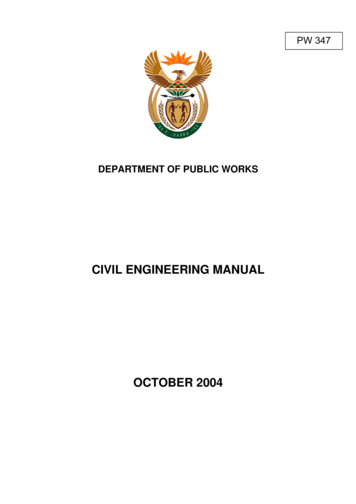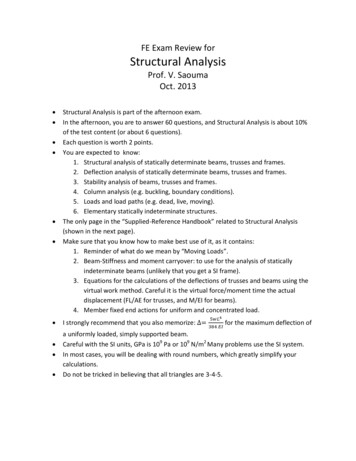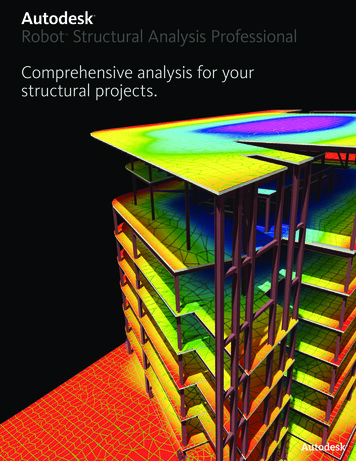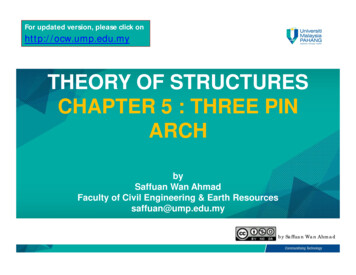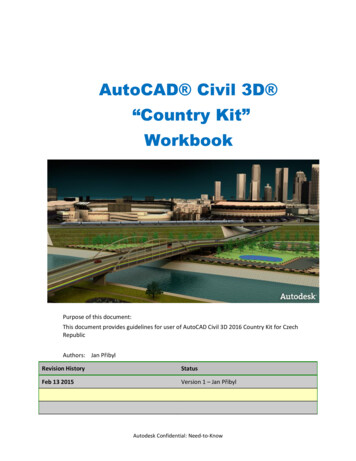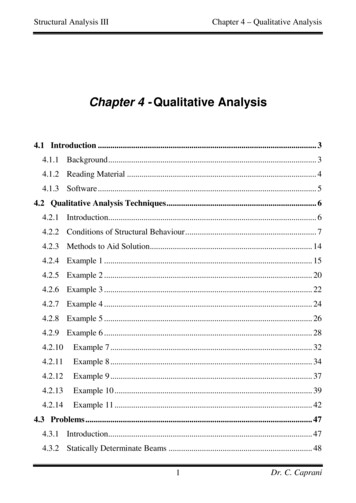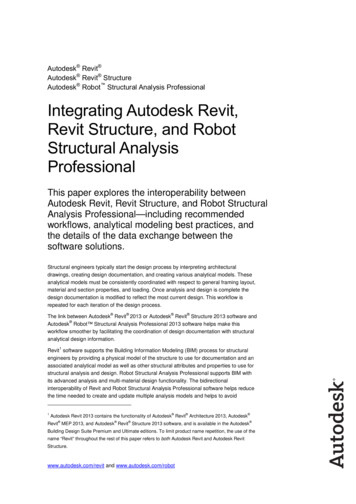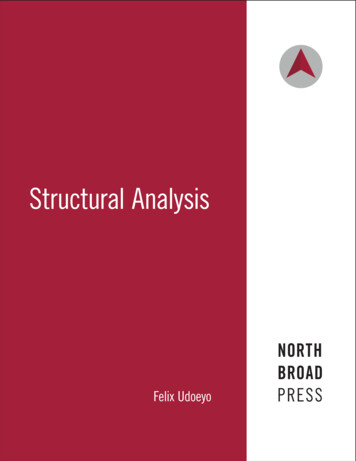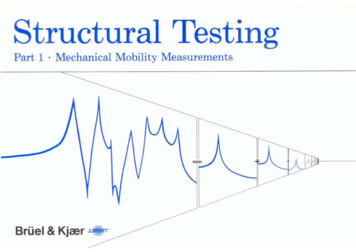
Transcription
STRUCTURAL ANALYSIS –IIB.TECHINCIVIL ENGINEERING5TH SEMDepartment of CIVIL ENGINEERINGBYPRAMODINI ROUTRAYSpintronic Technology & Advance Research (STAR)BHUBANESWAR
BCE 306 - STRUCTURAL ANALYSIS –IIModule – IIntroduction to Force and Displacement methods of structural analysis, Analysis ofcontinuous beam and plane frame by slope deflection method and moment distributionmethod.Module –IIAnalysis of continuous beam and simple portals by Kani’s method, Analysis of two pinnedand fixed arches with dead and live loads, suspension cable with two pinned stiffeninggirders.Module – IIIPlastic Analysis: Plastic modulus, shear factor, plastic moment of resistance, load factor,plastic analysis of continuous beam and simple rectangular portals, Application of upper andlower bound theoremsModule – IVMatrix method of analysis: flexibility and stiffness method, Application to simple trusses andbeamReference Books1. Indeterminate Structures by J.S. Kenney2. Indeterminate Structures By C.K. Wang.3. Matrix methods of Structural Analysis By Pandit and Gupta2Under Revision
INTRODUCTION TO FORCESTRUCTURAL ANALYSISANDDISPLACEMENTMETHODSOFSince twentieth century, indeterminate structures are being widely used for its obviousmerits. It may be recalled that, in the case of indeterminate structures either the reactionsor the internal forces cannot be determined from equations of statics alone. In suchstructures, the number of reactions or the number of internal forces exceeds the numberof static equilibrium equations. In addition to equilibrium equations, compatibility equationsare used to evaluate the unknown reactions and internal forces in statically indeterminatestructure. In the analysis of indeterminate structure it is necessary to satisfy theequilibrium equations (implying that the structure is in equilibrium) compatibility equations(requirement if for assuring the continuity of the structure without any breaks) andforce displacement equations (the way in which displacement are related to forces). Wehave two distinct method of analysis for statically indeterminate structure depending uponhow the above equations are satisfied:1. Force method of analysis2. Displacement method of analysisIn the force method of analysis,primary unknown are forces.In this method compatibilityequations are written for displacement and rotations (which are calculated by forcedisplacement equations). Solving these equations, redundant forces are calculated. Once theredundant forces are calculated, the remaining reactions are evaluated by equations ofequilibrium.primaryunknownsaretheIn the displacement method of analysis,thedisplacements. In this method, first force -displacement relations are computed andsubsequently equations are written satisfying the equilibrium conditions of the structure.After determining the unknown displacements, the other forces are calculated satisfyingthe compatibility conditions and force displacement relations The displacement-basedmethod is amenable to computer programming and hence the method is beingwidely used in the modern day structural analysis.DIFFERENCE BETWEEN FORCE & DISPLACEMENT METHODSFORCE METHODS1.2.3.4.DISPLACEMENT METHODS1.2.3.4.Method of consistent deformationTheorem of least workColumn analogy methodFlexibility matrix methodTypes of indeterminacy- static indeterminacySlope deflection methodMoment distribution methodKani’s methodStiffness matrix Under Revision
Governing equations-compatibility equationsForce displacementmatrixrelations-Governing equations-equilibrium equationsflexibility Force displacement relations- stiffness matrixAll displacement methods follow the above general procedure. The Slope-deflection andmoment distribution methods were extensively used for many years before the computer era.In the displacement method of analysis, primary unknowns are joint displacements which arecommonly referred to as the degrees of freedom of the structure. It is necessary to considerall the independent degrees of freedom while writing the equilibrium equations.These degreesof freedom are specified at supports, joints and at the free ends.SLOPE DEFLECTION METHODIn the slope-deflection method, the relationship is established between moments at the endsof the members and the corresponding rotations and displacements.The slope-deflection method can be used to analyze statically determinate and indeterminatebeams and frames. In this method it is assumed that all deformations are due to bending only.In other words deformations due to axial forces are neglected. In the force method of analysiscompatibility equations are written in terms of unknown reactions. It must be noted that allthe unknown reactions appear in each of the compatibility equations making it difficult tosolve resulting equations. The slope-deflection equations are not that lengthy in comparison.The basic idea of the slope deflection method is to write the equilibrium equations for eachnode in terms of the deflections and rotations. Solve for the generalized displacements. Usingmoment-displacement relations, moments are then known. The structure is thus reduced to adeterminate structure. The slope-deflection method was originally developed by HeinrichManderla and Otto Mohr for computing secondary stresses in trusses. The method as usedtoday was presented by G.A.Maney in 1915 for analyzing rigid jointed structures.Fundamental Slope-Deflection Equations:The slope deflection method is so named as it relates the unknown slopes and deflections tothe applied load on a structure. In order to develop general form of slope deflectionequations, we will consider the typical span AB of a continuous beam which is subjected toarbitrary loading and has a constant EI. We wish to relate the beams internal end momentsin terms of its three degrees of freedom, namely its angular displacementsand linear displacement which could be caused by relative settlements betweenthe supports. Since we will be developing a formula, moments and angular displacementswill be considered positive, when they act clockwise on the span. The linear displacementwill be considered positive since this displacement causes the chord of the span and thespan’s chord angle to rotate clockwise. The slope deflection equations can be obtained by5Under Revision
using principle of superposition by considering separately the moments developed at eachsupports due to each of the displacements&Case A: fixed-end moments, ,6Under Revision
,Case B: rotation at A,(angular displacement at A)Consider node A of the member as shown in figure to rotate while its far end B is fixed. Todetermine the momentneeded to cause the displacement, we will use conjugate beammethod. The end shear at A acts downwards on the beam sinceis clockwise.,Case C: rotation at B,(angular displacement at B)In a similar manner if the end B of the beam rotates to its final position,while end A isheld fixed. We can relate the applied momentto the angular displacementand thereaction moment7Under Revision
,Case D: displacement of end B related to end AIf the far node B of the member is displaced relative to A so that so that the chord of themember rotates clockwise (positive displacement) .The moment M can be related todisplacement by using conjugate beam method. The conjugate beam is free at both the endsas the real beam is fixed supported. Due to displacement of the real beam at B, the moment atthe end B of the conjugate beam must have a magnitude of .Summing moments about B we have,-By our sign convention the induced moment is negative, since for equilibrium it acts counterclockwise on the member.If the end moments due to the loadings and each displacements are added together, then theresultant moments at the ends can be written as,8Under Revision
Fixed end moment table9Under Revision
General Procedure OF Slope-Deflection Method Find the fixed end moments of each span (both ends left & right).Apply the slope deflection equation on each span & identify the unknowns.Write down the joint equilibrium equations.Solve the equilibrium equations to get the unknown rotation & deflections.Determine the end moments and then treat each span as simply supported beamsubjected to given load & end moments so we can work out the reactions & drawthe bending moment & shear force diagram.10Under Revision
Numerical Examples1. Q. Analyze two span continuous beam ABC by slope deflection method. Then drawBending moment & Shear force diagram. Take EI constant.Fixed end moments areSince A is fixedSlope deflection equations areIn all the above 4 equations there are only 2 unknownsconditions areand accordingly the boundaryas end C is simply supported.Solving the equations (5) & (6), we get11Under Revision
Substituting the values in the slope deflections we have, -51.38 KNmReactions: Consider the free body diagram of the beamFind reactions using equations of equilibrium.Span AB: MA 0 , RB 6 100 4 75-51.38RB 70.60 KNV 0,RA RB 100KNRA 100-70.60 29.40 KNSpan BC: MC 0, RB 5 20 5 75RB 65 KNV 0 RB RC 20 5 100KNRC 100-65 35 KNUsing these data BM and SF diagram can be drawn12Under Revision
Max BM:Span AB: Max BM in span AB occurs under point load and can be found geometrically,Mmax 113.33-51.38 – ()Span BC: Max BM in span BC occurs where shear force is zero or changes its sign. Henceconsider SF equation w.r.t CSx 35-20x 0 1.75mMax BM occurs at 1.75m from CMmax 35 1.75 – 2013Under Revision
2. Q. Analyze continuous beam ABCD by slope deflection method and then draw bendingmoment diagram. Take EI constant.Slope deflection equations areIn all the above equations there are only 2 unknownsconditions areand accordingly the boundarySolving equations (5) & (6),14Under Revision
Substituting the values in the slope deflections we have, -61 KNmReactions: Consider free body diagram of beam AB, BC and CD as shown15Under Revision
Span AB:RB 6 100 4 67.11- 61RB 67.69KNRA 100- RB 32.31 KNSpan BC:RC5 20- 67.11RC 42.58 KNRB 205- RC 57.42KNMaximum Bending Moments:Span AB: Occurs under point loadMmax Span BC: Where SF 0, consider SF equation with C as referenceSx 42.58-20x 0x Mmax 3. Q. Analyse the continuous beam ABCD shown in figure by slope deflection method. Thesupport B sinks by 15mm.Take E 200 105 KN/m2 and I 120 10-6m416Under Revision
A.FEM due to yield of support BFor span AB:MAB MBA For span BC:MBC MCB Slope deflection equations areIn all the above equations there are only 2 unknownsconditions areand accordingly the boundary17Under Revision
Solving equations (5) & (6),Substituting the values in the slope deflections we have, -60.89 KNmConsider the free body diagram of continuous beam for finding reactionsREACTIONSSpan AB:RB 6 100 4 61.99-60.89RB 66.85KNRA 100- RB 33.15 KNSpan BC:RB5 2018Under Revision
RB 56.40 KNRC 205- RB 43.60KNAnalysis of frames (without & with sway)The side movement of the end of a column in a frame is called sway. Sway can be preventedby unyielding supports provided at the beam level as well as geometric or load symmetryabout vertical axis.19Under Revision
Frame with swaySway prevented by unyielding support4. Q. Analyse the simple frame shown in figure. End A is fixed and ends B & C are hinged.Draw the bending moment diagram.20Under Revision
Slope deflection equations areIn all the above equations there are only 3 unknownsboundary conditions areand accordingly the 021Under Revision
Solving equations (7) & (8) & (9),Substituting the values in the slope deflections we have,REACTIONS:SPAN AB:SPAN BC:22Under Revision
Column BD:5.Q. Analyse the portal frame and then draw the bending moment diagramA. This is a symmetrical frame and unsymmetrically loaded, thus it is an unsymmetricalproblem and there is a sway ,assume sway to rightFEMS:Slope deflection equations are23Under Revision
In the above equation there are three unknowns,conditions are,joint conditions,shear condition,, Now,,accordingly the boundary-56.25 Substitute in (7) & (8), equation (9),-56.25 -56.25- 093.75 24Under Revision
93.75 Solving equations (10) & (11), we getBy equation (10), , we have,Reactions: consider the free body diagram of beam and columnsColumn AB:25Under Revision
Span BC:Column CD:Check:H 0, HA HD 0, 22.5 – 22.5 0Hence okay6. Q. Frame ABCD is subjected to a horizontal force of 20 KN at joint C as shown infigure. Analyse and draw bending moment diagram.26Under Revision
A. The frame is symmetrical but loading is unsymmetrical. Hence there is a sway,assume sway towards right. In this problemFEMS: 112.5KNmSlope deflection equations:27Under Revision
In the above equation there are three unknowns,conditions are,Joint conditions,Shear condition,,, accordingly the boundaryNow,2.2112.5 2.20.375 0.3751.5Solving equations28Under Revision
, we have,Reactions: Consider the free body diagram of various members29Under Revision
Member AB:Span BC:Column CD:Check:H 0, HA HD 10 0, -5.2 34.81 10 030Under Revision
7.Q.Analyse the portal frame and draw the B.M.D.A. It is an unsymmetrical problem, hence there is a sway be towards right.FEMS:Slope deflection equations:31Under Revision
In the above equation there are three unknowns,conditions are,Joint conditions,Shear condition,,, accordingly the boundaryNow,41.67 2.2 0.3758Solving equations32Under Revision
, we have,Reactions: Consider the free body diagram33Under Revision
Member AB:Span BC:Column CD:Check:H 0, HA HD 0Satisfied, hence okay34Under Revision
MOMENT DISTRIBUTION METHODThis method of analyzing beams and frames was developed by Hardy Cross in 1930. Momentdistribution method is basically a displacement method of analysis. But this method side stepsthe calculation of the displacement and instead makes it possible to apply a series ofconverging corrections that allow direct calculation of the end moments. This method ofconsists of solving slope deflection equations by successive approximation that may becarried out to any desired degree of accuracy. Essentially, the method begins by assumingeach joint of a structure is fixed. Then by unlocking and locking each joint in succession, theinternal moments at the joints are distributed and balanced until the joints have rotated totheir final or nearly final positions. This method of analysis is both repetitive and easy toapply. Before explaining the moment distribution method certain definitions and conceptsmust be understood.Sign convention: In the moment distribution table clockwise moments will be treated veand anti clockwise moments will be treated –ve. But for drawing BMD moments causingconcavity upwards (sagging) will be treated ve and moments causing convexity upwards(hogging) will be treated –ve.Fixed end moments: The moments at the fixed joints of loaded member are called fixedend moment. FEM for few standards cases are given in previous chapter.Member stiffness factor:a) Consider a beam fixed at one end and hinged at other as shown in figure subjected to aclockwise couple M at end B. The deflected shape is shown by dotted line.BM at any section xx at a distance x from ‘B’ is given byIntegratingUsing condition at x L,35Under Revision
Integrating againUsing condition at x 0, y 0,Using at x L, y 0 in equation (2)Substituting in equation(1)Substituting at x 0,The term in parenthesisFor far end fixed . (4) is refered to as stiffness factor at B and canbe defined as moment M required to rotate end B of the beamb) Consider freely supported beam as shown in figure subjected to a clockwise couple M at BBy using MB 0And using V 0 RB er Revision
IntegratingIntegrating againSubstituting at x 0,The term in parenthesisis termed as stiffness factor at B when far end A is hinged . (5)Joint stiffness factor:If several members are connected to a joint, then by the principle of superposition the totalstiffness factor at the joint is the sum of the member stiffness factors at the joint i.e.,KT KE.g. For joint ‘0’, KT K0A KOB KOC KODDistribution factors: If a moment ‘M’ is applied to a rigid joint ‘o’, as shown in figure, theconnecting members will each supply a portion of the resisting moment necessary to satisfymoment equilibrium at the joint. Distribution factor is that fraction which when multipliedwith applied moment ‘M’ gives resisting moment supplied by the members. To obtain its37Under Revision
value imagine the joint is rigid joint connected to different members. If applied moment Mcause the joint to rotate an amount ‘ ’, Then each member rotates by same amount.From equilibrium requirementM M1 M2 M3 DF1 In general DF . .(6)Member relative stiffness factor: In majority of the cases continuous beams and frames willbe made from the same material so that their modulus of electricity E will be same for allmembers. It will be easier to determine member stiffness factor by removing term 4E & 3Efrom equation (4) and (5) then will be called as relative stiffness factor.for far end fixedfor far end hingedCarry over factors: Consider the beam shown in figureWe have shown thatBM at A ve BM ofat A indicates clockwise moment ofat A. In other words the moment ‘M’ atthe pin induces a moment of at the fixed end. The carry over factor represents the fractionof M that is carried over from hinge to fixed end. Hence the carry over factor for the case offar end fixed is . The plus sign indicates both moments are in the same direction.Moment distribution method for beams:Procedure for analysis:(i) Fixed end moments for each loaded span are determined assuming both ends fixed.(ii) The stiffness factors for each span at the joint should be calculated. Using these values thedistribution factors can be determined from equation DF DF for a fixed end 0 and DF 1 for an end pin or roller support.(iii) Moment distribution process: Assume that all joints at which the moments in theconnecting spans must be determined are initially locked.38Under Revision
Then determine the moment that is needed to put each joint in equilibrium. Release or unlockthe joints and distribute the counterbalancing moments into connecting span at each jointusing distribution factors.Carry these moments in each span over to its other end by multiplying each moment by carryover factor.By repeating this cycle of locking and unlocking the joints, it will be found that the momentcorrections will diminish since the beam tends to achieve its final deflected shape. When asmall enough value for correction is obtained the process of cycling should be stopped withcarry over only to the end supports. Each column of FEMs, distributed moments and carryover moment should then be added to get the final moments at the joints.Then superimpose support moment diagram over free BMD (BMD of primary structure) finalBMD for the beam is obtained.1.Q. Analyse the beam shown in figure by moment distribution method and draw the BMD.Assume EI is constantA. FEMS -250KNm 250KNm(ii) Calculation of distribution factors(iii) The moment distribution is carried out in table below.39Under Revision
After writing FEMs we can see that there is a unbalancing moment of –240 KNm at B & -10KNm at joint C. Hence in the next step balancing moment of 240 KNM & 10 KNm areapplied at B & C Simultaneously and distributed in the connecting members after multiplywith D.F. In the next step distributed moments are carried over to the far ends. This process iscontinued until the resulting moments are diminished an appropriate amount. The finalmoments are obtained by summing up all the moment values in each column.Drawing of BMD is shown below in figure.2. Q. Analyse the continuos beam as shown in figure by moment distribution method anddraw the B.M. diagrams40Under Revision
Support B sinks by 10mmE 2 x 105 N/mm², I 1.2 x 10-4 m4A. FEMSmmmDistribution factor41Under Revision
MOMENT DISTRIBUTION42Under Revision
BMDMoment distribution for frames: (No side sway)The analysis of such a frame when the loading conditions and the geometry of the frame issuch that there is no joint translation or sway, is similar to that given for beams.3. Q. Analysis the frame shown in figure by moment distribution method and drawBMD assume EI is constant.43Under Revision
FEMSDISTRIBUTION FACTORMOMENT DISTRIBUTION44Under Revision
BMDMoment distribution method for frames with side swayFrames that are non symmetrical with reference to material property or geometry (differentlengths and I values of column) or support condition or subjected to non-symmetrical loadinghave a tendency to side sway.4.Q. Analyze the frame shown in figure by moment distribution method. Assume EI isconstant.A. Non Sway Analysis:First consider the frame without side sway45Under Revision
DISTRIBUTION FACTORDISTRIBUTION OF MOMENTS FOR NON-SWAY ANALYSISFREE BODY DIAGRAM OF COLUMNS46Under Revision
By seeing of the FBD of columns R 1.73 – 0.82(Using Fx 0 for entire frame) 0.91 KNNow apply R 0.91 KN acting opposite as shown in the above figure for the sway analysis.Sway analysis: For this we will assume a force R’ is applied at C causing the frame to deflectas shown in the following figure.Since both ends are fixed, columns are of same length & I and assuming joints B & C aretemporarily restrained from rotating and resulting fixed end moment areAssumeMoment distribution table for sway analysis:47Under Revision
Free body diagram of columnsUsing F x 0 for the entire frameR’ 28 28 56 KNHence R’ 56KN creates the sway moments shown in above moment distribution table.Corresponding moments caused by R 0.91KN can be determined by proportion. Thus finalmoments are calculated by adding non sway moments and sway.Moments calculated for R 0.91KN, as shown below.48Under Revision
BMD5.Q. Analysis the rigid frame shown in figure by moment distribution method and drawBMDA. Non Sway Analysis:First consider the frame held from side swayFEMS49Under Revision
DISTRIBUTION FACTORDISTRIBUTION OF MOMENTS FOR NON-SWAY ANALYSIS50Under Revision
FREE BODY DIAGRAM OF COLUMNSApplying Fx 0 for frame as aWhole, R 10 – 3.93 – 0.73 5.34 KNNow apply R 5.34KN acting oppositeSway analysis: For this we will assume a force R’ is applied at C causing the frame todeflect as shown in figureSince ends A & D are hinged and columns AB & CD are of different lengths,,51Under Revision
Assume,MOMENT DISTRIBUTION FOR SWAY ANALYSISFREE BODY DIAGRAMS OF COLUMNS AB &CD16.36 KNm35.112.34 KNKNm8.78 KN8.78 KN2.34 KNUsing Fx 0 for the entire frameR’ 11.12 kN52Under Revision
Hence R’ 11.12 KN creates the sway moments shown in the above moment distributiontable. Corresponding moments caused by R 5.34 kN can be determined by proportion.Thus final moments are calculated by adding non-sway moments and sway momentsdetermined for R 5.34 KN as shown below.020 KNm19.78 KNm4.63KNm4.63KNm19.78 KNm17.4KNmB.M.D53Under Revision
Plastic Analysis: Plastic modulus, shear factor, plastic moment of resistance, load factor, plastic analysis of continuous beam and simple rectangular portals, Application of upper and lower bound theorems . Module - IV Matrix method of analysis: flexibility and stiffness method, Application to simple trusses and beam . Reference Books . 1.

